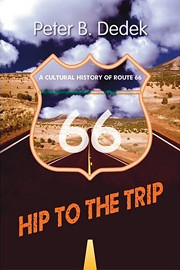Just when you think there are no more new avenues to books about Route 66’s history, Peter Dedek finds unexplored backroads and obscure alignments in his “Hip to the Trip: A Cultural History of Route 66” (169 pages, University of New Mexico Press, $19.95).
Dedek, a professor at Texas State University, diligently researches the history of the Main Street of America and explores its mythology. He deconstructs its rosy nostalgia, yet still seems to be a fan of the road.
Street of America and explores its mythology. He deconstructs its rosy nostalgia, yet still seems to be a fan of the road.
I’ve read many books about the history of the road, but Dedek dredged up material I’d never heard before.
For instance, Route 66 tourism campaigns can trace their roots to the railroads in the 19th century that touted the American Southwest as a vacation getaway.
Promotion by railroads, dime novels with western themes, and acts such as Buffalo Bill’s Wild West Show provided easterners with a highly romanticized and often fictional perspective on the formerly “wild” but recently tamed Indians living in a still “untamed” southwestern landscape.
Another thing I learned is that immediately after World War II, the pavement of Route 66 was a mess. Monies that normally went to road maintenance were concentrated on the war effort, and officials looked the other way on overweight trucks because many were hauling military equipment.
Dedek keeps finding historical nuggets like that. With more than 30 pages of footnotes and bibliography, it’s obvious he did a lot of work on this project.
He also tackles the “postmodern nostalgia” that’s part of Route 66. Many writers describe the Mother Road’s heyday of the 1950s in flowery terms as a more innocent, uncomplicated time. But that era was beset by racism, the Cold War, McCarthyism, the stirrings of the sexual revolution and a highway that was so dangerous that it was referred to as “Bloody 66.” Such debunking is needed. Yet Dedek is not mean-spirited. I get the impression he still gets a kick out of Route 66 and the nostalgia it generates.
Dedek concludes with the chapter “Saving the Mythic Ruins,” in which he examines preservation avenues for the Mother Road. It should provide food for thought for 66ers who want to keep their road around for future generations.
Although Dedek takes a largely academic approach, “Hip to the Trip” avoids the stuffy, elitist stench that permeates other books of its ilk. It’s well-written, well-reasoned, and will spark thought in the most seasoned roadie.
Highly recommended.
I was looking forward to this book release for months prior to its release. I finally received the first autographed copy and I believe that 76% of the information and readings are false. I feel that Dr. Dedek needs to check and re-check his references on his “Hip To The Trip” is absurd and inappropriate! I felt so compelled to writing this comment because he left me in such a hatred mood. The readings are very tactful and yet undefined. HOWEVER, the part that I really think looks good is the front cover. GOOD CHOICE DEDEK! But be aware and do not open, waste of time. Thank you for nothing!
Sarah, I don’t believe you.
There are more than 30 pages of footnotes — many sources of which I am familiar. It was peer-reviewed at the university where he submitted it. I am well-acquainted with the history of the road, and everything that Dedek writes rings true. It challenges some preconceptions, but that’s what good works often do — and it backs it up with facts.
Mr. Dedek has been more than forthcoming with his source material. It’s time for you, Ms. Gillmuthe, to be as forthcoming and specific with your rebuttals.
I’m unsure what Ms. Gillmuthe is basing her criticism of the book on. This is an academic, peer reviewed work which I researched very carefully. More than 2,000 people have read the book since its publication and the only error that has been brought to my or the publisher’s attention was that I stated that the old Club Cafe building in Santa Rosa, New Mexico, had been demolished when in fact the cafe is closed but the building remains standing (the building next door was torn down). We corrected that mistake prior to the book’s second printing.
While I welcome any criticism of my work which has some basis in fact, I do not feel that Gillmuthe’s attack is fair because she doesn’t support her suppositions, for example, what makes the book “absurd and inappropriate.” To be at all convincing, one has to explain the rationale behind inflammatory statements such as that.